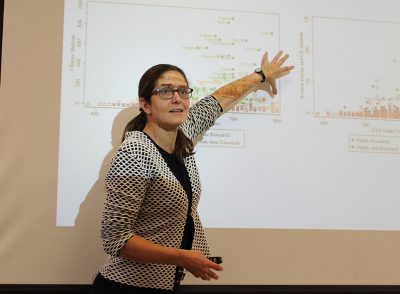
Editor’s Note: Chelsea Connery ’13 (ED), ’14 MA, a former public school teacher and now a Neag School doctoral student in the Learning, Leadership, and Education Policy program, prepared the following issue brief — in affiliation with the Center for Education Policy Analysis (CEPA) — about the impact of undocumented status on children’s learning, as well as the implications for schools.
In recent decades, U.S. immigration policy has restricted access and pathways to citizenship for undocumented immigrants,[i] those individuals who live in a country without legal authorization to do so. These individuals are not United States citizens, do not hold current permanent resident visas, and have not been granted admission under rules for longer-term residence and work permits.[ii] Many exist in a state of “liminal legality”[iii] with ambiguous documentation. In a context of contentious and shifting immigration policy, undocumented children and families face unique challenges that can affect their schooling experience and require the attention and care of educators.
In recent decades, U.S. immigration policy has restricted access and pathways to citizenship for undocumented immigrants,[i] those individuals who live in a country without legal authorization to do so. These individuals are not United States citizens, do not hold current permanent resident visas, and have not been granted admission under rules for longer-term residence and work permits.[ii] Many exist in a state of “liminal legality”[iii] with ambiguous documentation. In a context of contentious and shifting immigration policy, undocumented children and familiesface unique challenges that can affect their schooling experience and require the attention and care of educators.
In a context of contentious and shifting immigration policy, undocumented children and families face unique challenges that can affect their schooling experience and require the attention and care of educators.
This brief addresses issues that are relevant for schools and districts enrolling undocumented immigrants who arrive in the U.S. as young children, those who come as teenagers or young adults, and those children who are documented with undocumented family members. The purpose of this brief is to explore (1) social, emotional, and mental health impacts of immigrant and undocumented status, (2) the ramifications of these impacts on learning, and (3) their implications for schools.
The Context: Immigration Policy and K-12 Students
K-12 immigrant students are extremely vulnerable to changes in immigration policy. President Obama initiated the immigration policy known as the Deferred Action for Childhood Arrivals (DACA) in 2012. DACA provided undocumented immigrants who entered the U.S. at a young age a two-year renewable deferment from deportation and eligibility to work and pursue higher education.[iv] DACA-granted individuals could apply for social security numbers, driver licenses, and bank accounts, thus facilitating their mobility and integration into the U.S.[v] While DACA was not ideal policy,[vi] for many undocumented immigrant students it created a brighter future, with more freedom and independence.[vii]
Changing policy direction, the Trump administration repealed DACA in 2017. The DACA repeal, without concurrent immigration reform and coupled with increased immigration enforcement, has heightened widespread fear.[viii] The anti-immigrant rhetoric of the Trump administration and the repeal of DACA have caused stress, anxiety, and tension for students and their families.[ix] If reflected in the school environment, political tensions can be detrimental to immigrant students, whose social and academic potential greatly relies on a hospitable, discrimination-free school environment.[x]

Demographic research shows that Connecticut is home to a sizeable number of undocumented immigrants. As of September 2017, 11,000 undocumented individuals in the state met DACA criteria and 3,800 were DACA recipients. However, there are approximately 120,000 total undocumented individuals in the state[xi] and approximately 32,810 of these individuals are children under the age of 17.[xii] The U.S. Supreme Court ruled that states cannot deny undocumented children a free public education.[xiii] Thus, there are roughly 12,000 students between the ages of 3 and 24 enrolled in public school.[xiv] Furthermore, 5.5 percent of K-12 students have at least one undocumented immigrant parent and 40,931 Connecticut children are U.S. citizens living with at least one undocumented family member.[xv] These numbers suggest that Connecticut educators ought to be informed about the needs of undocumented students in today’s schools.
How Does Immigration and Undocumented Status Affect Learning?
The repeal of DACA, lack of action on comprehensive immigration reform legislation, and current anti-immigrant rhetoric are converging to create a particularly distressing environment for undocumented students and citizen students with undocumented family. These students’ experiences can adversely affect their social, emotional, and mental well-being. In turn, these challenges can affect their ability to learn. Educators can better support these students if they understand the students’ pre- and post-migration experiences, undocumented status, fear of deportation, and socioeconomic status.
Pre- and Post-Migration Experiences
Pre-migration experiences shape children’s post-migration life. Motivation for migration and events prior to the immigration experience constitute risk factors for immigrant youth.[xvi] For example, a study of recent immigrant school children (8-15 years old) revealed that exposure to pre-immigration violence was prevalent and positively associated with post-traumatic stress disorder and depressive symptoms.[xvii] Undocumented students may also experience psychological stress exacerbated by the entry experience, a process that has become more dangerous due to increased border surveillance[xviii]and the separation of families at the border.[xix] In addition, acculturative stress, which stems from challenges associated with adjusting to life in the U.S., affects psychological well-being.
Stressors faced by immigrant students can drain their coping capacities and leave them vulnerable to academic failure.
Post-migration experiences can also induce stress. Studies find a positive association between acculturative stress and low self-esteem, depression, and greater suicidal alienation.[xx] Additionally, the psychological burden of being stigmatized and vilified by media and the broader society manifests in the daily experiences, perceptions, and actions of undocumented immigrants thus putting them at greater risk for low self-esteem, guilt, shame, fear, and insecurity.[xii]Regular experiences of perceived discrimination can cause psychological distress, major depression, and generalized anxiety.[xxii]
Stressors faced by immigrant students can drain their coping capacities and leave them vulnerable to academic failure. Acculturative stress and perceived discrimination (measured as experiences of prejudiced behaviors or observations of discrimination toward others in the school setting) are significant contributors to academic problems.[xxiii] Anti-immigrant climate, xenophobia, and discrimination also exacerbate acculturative stress.[xxiv] In addition to these experiences, students’ legal status also influences the post-migration acculturative experience for students and their families.
Undocumented Status
Legal status shapes the lives of immigrant youth in myriad ways. Socio-legal factors, include immigration laws, affect immigrant integration and mobility,[xxv] identity, sense of belonging,[xxvi] and health.[xxvii] For undocumented students, these social and legal factors can affect access to education, health insurance, and public programs such as food stamps; family dynamics; and relationships with other social institutions.[xxviii] Even if youth themselves are citizens, their undocumented guardians may not entirely understand their child’s eligibility and/or fear that seeking help puts them at risk for deportation.[xxix] Immigration laws and policies are commonly portrayed as necessary to restrict undocumented immigration yet research demonstrates this form of deterrence is largely ineffectual, particularly given that individuals crossing the border are often refugees.[xxx] Ultimately, immigration laws and policies often result in acute fear of deportation and a life of perpetual anxiety for undocumented immigrants.[xxxi]
Fear of Deportation

Undocumented youth face uncertainty, fear, and stress, leading to psychological issues including depression, anxiety and an increased risk of suicide.[xxxii] Fear of deportation negatively shapes self-image and positively predicts stress.[xxxiii] Extended exposure to stress, especially during childhood and adolescence, is known to create long-standing consequences (e.g. decreased cognitive performance, short term and working memory, and impulse control) due to structural and functional changes in individuals’ capacity to deal with and react to stress.[xxiv]
Due to various circumstances, many immigrant families are composed of individuals with diverse immigration status — “mixed-status” families.[xxxv] Older siblings may be undocumented, whereas younger siblings may hold U.S. citizenship. An aunt or an uncle may have obtained legal residency, while a parent may be in the process of filing for papers.[xxxvi] Citizen youth in mixed status families can suffer from the stresses associated with documentation status.[xxxvii] Thus, even DACA recipients encountered hardships related to the blocked pathway to legalization of their families. Over the last several years, enforcement efforts have increased levels of anxiety in immigrant communities and families. A survey of DACA recipients indicate that 49 percent worry “all the time” or “most of the time” that friends and family members will be deported.[xxxviii]
Even in the absence of actual deportation, worries about its possibility may affect children’s development by increasing their anxiety and influencing their ability to concentrate in school.[xxxix] Childhood mental health or behavioral problems such as depression negatively influence academic performance as measured by standardized tests. Some studies have also consistently shown the negative impact of childhood and adolescent anxiety on academic performance.[xl] Mental health and behavioral problems also increase the likelihood of dropping out of high school and not attending college.[xli]
Parental Detention and Deportation
Parent-child separations due to detainment or deportation pose serious risks to children’s immediate safety, economic security, well-being, and longer-term development.[xlii] These considerations are particularly relevant given the Trump administration’s introduction of a “zero-tolerance” policy calling for the criminal prosecution of all individuals — including asylum seekers — who cross the border between checkpoints which has had the effect of systematically separating parents from their children when they enter the country together because parents are referred for criminal prosecution.[xliii] Separated children may be released to sponsors but are first held in shelters or juvenile detention centers, and release to sponsor is not guaranteed.[xliv] This “zero-tolerance” policy was not ended by the most recent executive order – instead it detains children with their parents, instead of separating them, while their legal cases are considered.
More than 5 percent of K-12 students have at least one undocumented immigrant parent, and 40,931 Connecticut children are U.S. citizens living with at least one undocumented family member.
For children who experience traumas, parents and caregivers provide critical protection, helping children regulate their emotions and reestablish a sense of safety which affects their stress-response system and their growth, health, and well-being. When children are unnecessarily and traumatically removed from parents or guardians their physical and mental health and well-being suffers.[xlv] A study on the consequences of parental arrest, detention, and deportation on children revealed that about two-thirds of children experienced changes in eating and sleeping habits. More than a third of children were more anxious, withdrawn, clingy, angry, or aggressive. Most children experienced four or more of these behavioral changes. Younger children experienced greater difficulties eating and sleeping, excessive crying, and clinging to family and parents upon their release[xlvi], while aggressive and withdrawn behavior was more common among older children.[xlvii] Another study found that after the arrest or detention of their parents, children experienced feelings of abandonment and showed symptoms of emotional trauma, psychological duress, and mental health issues.[xlviii] However, due to fear of possible consequences in asking for assistance, and barriers to accessing services, few affected immigrants sought mental health care for themselves or their children.[xlix]
Trauma, like that described above, has a significant impact on cognitive development and academic outcomes. Children with four or more “adverse childhood experiences” are 32 times more likely to be labeled with a learning or behavior problem than a child with no adverse childhood experiences.[l] Furthermore, youth with mental health problems and deficits in social emotional competence have difficulty learning.[li]
Socioeconomic Status
All of these stressors are amplified by the fact that undocumented students tend to come from families with modest incomes. Nearly 40 percent of undocumented children live below the federal poverty level (compared with 17 percent of native-born children).[lii] Across many studies, poverty is associated with a range of negative outcomes for children’s physical health, language and cognitive development, academic achievement, and educational attainment as well as mental, emotional, and behavioral health.[liii] Furthermore, the effects of poverty are cumulative; consequences at one stage in a child’s development can hinder development at a later stage.[liv]
Children of immigrants are at higher risk of cognitive and language developmental issues as well as lower academic performance.[lv] Children of undocumented parents, in particular, are at a disadvantage in school readiness compared to children of authorized individuals.[lvi] Research demonstrates that undocumented status has a harmful influence on children’s cognitive skills as early as at 2 and 3 years of age.[lvii] This influence is attributed to increased parental economic hardship and psychological distress combined with lower availability of social support and lower levels of information about public resources that could help children’s cognitive development.[lviii] The undocumented status of families can directly and indirectly cut off access from vital public programs such as early childhood education that can improve cognitive and behavioral development of immigrant children.[lix] These circumstances were also associated with lower academic achievement in middle childhood.[lx]
Promoting Positive Outcomes: Recommendations
Despite these students’ challenging circumstances, research suggests how schools can promote positive outcomes among undocumented students.

Environment
Studies have consistently shown that a safe, welcoming, and supportive schooling environment can help immigrant students overcome difficulties at school, in the community, and within the family.[lxi] These studies suggest that school must be a positive place, where immigrant students—whether foreign- or U.S.- born, documented or undocumented—feel a strong sense of belonging and encouragement to move forward in the future.[lxii] Thus, I recommend that districts or schools:
- Provide mandatory professional development for educators and staff on: cultural competence to create a caring community of learners and enhance school and classroom climate; existing laws affecting undocumented students; social, emotional, and mental health consequences of immigration and undocumented status of students and their families.
- Create a working list of contacts for local community organizations, university partnerships, and other resources (e.g. lawyers, community leaders, immigrant-serving organizations) that educators and staff can refer to if a concern or question arises with a student or family.
- Partner with local community organizations and/or universities to implement professional development and build organizational connections.
- Clarify how they will interact with external agencies such as Immigration and Customs Enforcement or the Office of Refugee Resettlement. These clarifications can make the climate feel safer for students and families.
Relationships
Relationships in school play a crucial role in promoting socially competent behavior in the classroom and fostering academic engagement and achievement.[lxiii] Undocumented students who are able to maintain strong friendships and have caring adults (teachers, counselors, or other adult mentors) with whom they can talk openly about their struggles describe less emotional distress and are much more likely to remain at school.[lxiv]
Additionally, youth who connect with others in similar circumstances feel less isolated. Participation in civic activities to effect change can serve as a catalyst out of “learned helplessness” into “learned hopefulness”.[lxv] Thus, I recommend that schools:
- Implement advisory groups designed to provide opportunities for mentoring and building peer relationships in a fun, relaxing environment.
- Establish a structure of smaller communities or teams within schools and build trust among school staff, families, and students, thereby increasing student access to guidance and support from school staff and other students.[lxvi]
- Design and facilitate support groups for immigrant students.[lxvii]
- Design programs that support newcomer students by creating a community of peers experiencing the same transitions.
- When necessary, provide longer term counseling for students (and, perhaps, families, through community connections) to mitigate psychological effects.
These efforts must be coordinated and integrated. School administrators must provide strong leadership and support to ensure meaningful staff development and implementation.
CEPA is a research center based at the Neag School that seeks to inform educational leaders and policymakers on issues related to the development, implementation, and consequences of education policies. Learn more about CEPA at cepa.uconn.edu. Access the original PDF of this issue brief (including all references), as well as other CEPA presentations and publications, online.
Related Stories:
 Facebook
Facebook
 Twitter
Twitter
 LinkedIn
LinkedIn
